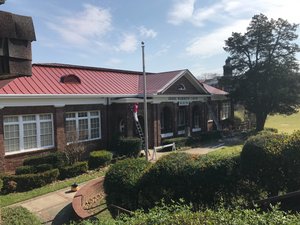Advertisement
Published: March 22nd 2017

 IMG_0114
IMG_0114
George Washington Carver MuseumTuskegee Institute National Historic Site
Tuskegee Airmen National Historic Site
Tuskegee, AL
This was another itinerary item added by Joan as part of her rebellion against the tyranny of The Bucket List. (See The Whiskey Rebellion post for another one). These two sites were the reason that we traveled to Auburn at all. Although administered by the Park Service, National Historic Sites are not part of my bucket list because there are just too many of them, requiring lots of added travel to incorporate, and because they are usually just good for an hour or two of sightseeing. You end up traveling a ways, usually spending an extra day camping for not a whole lot of added value. But Joan wanted to see these two sites specifically, and so we added this jaunt to the itinerary. It also meant an extra couple of nights in Alabama that ended up being a delightful, and very southern, addition to our experience.
So yesterday we drove the 14 miles down to Tuskegee to see these two little parks. The first one is really just two buildings out of the many on the Tuskegee University campus. However, the George

 IMG_0115
IMG_0115
Tuskegee University Student UnionWashington Carver Museum, which also housed the visitor center, was closed for renovation.
It looked like we were in for a very disappointing visit, so we just sort of hiked around the campus. All the buildings are of brick construction here. And, it turns out that most of the bricks are made here from local clay. I especially enjoyed looking at the chapel - a modern building that boasts there isn't a single right angle anywhere inside or outside of the building. That's a rather singular architectural achievement and gives the structure a fluid look. The quad center of the campus is a hollow which, it turns out, is where much of the dirt to make the bricks came from. So the campus has an interesting and coherent look to it.
But we really didn't learn anything until we went to the Oak House, the second part of the historic site. There two young men, architecture students at the school, were working with the park service as part of their academic work. Just 22 years old, they gave us the tour of the building and provided many important details in the story.
Oak House was the home
of Booker T. Washington, the man, who barely as old as our tour guides, built Tuskegee Normal School, originally established by the state of Alabama, into a world renown Institute. His attitude for both the school and for the schools students was one of self-sufficiency. Students supplied much of the labor in building, maintaining, and operating the school as, basically, an early form of student financial aid. In fact, it was students that built the Presidents house, Oak House. The guides even pointed out that, after they began construction on a staircase from the second to the third floor, they realized it wouldn't work. So, with steps still in place, they turned it into a closet. (As an architecture student, he said he would have flunked his class if he had done that!)
When Washington created the school of agriculture, he hired George Washington Carver to head it up. Some of his most important research into plants was done here, especially his work with peanuts - an important crop in this part of the world. Booker was the first black to be entertained at the White House (although the guide said that after he left, the staff had to

 IMG_0119
IMG_0119
Booker T. Washington Memorialburn or otherwise destroy everything he had come in contact with). Carver was the first black to have tea at the White House, although with the same result.
The Institute sought to become involved in the US war effort by noting that nowhere in the US was there a place to train black men to pilot military aircraft. So in 1941, they established a training program at nearby Morton Air Field field. During the course of the war, more than 2500 men started training there, although only 1000 graduated because the program was so tough. Those men went on to serve valiantly in the war effort earning 59 Purple Hearts and destroying dozens of enemy planes. There is a separate historic site out on the airfield a few miles out of town that commemorates and documents their service. I especially liked the 1940s style telephones that you could pick up and dial a number to hear recordings from the men and a few women who were either trained there or were supported their efforts. It is a moving exhibit.
What I find especially interesting about both of these sites is how much they accomplished right here in the

 IMG_0120
IMG_0120
Oak Housecenter of what had to be a hostile, Jim Crow, environment. There are stories of black men from northern states, who had to move into 'the black car' on the train to Tuskegee when they crossed the Mason Dixon Line. That this group of people, both the pilots and the team at what is now Tuskegee University, could survive and prosper here is a testament to their courage and perseverance.
Joan has had a strong interest in the histories of oppressed people. She pays attention to the ongoing struggles of black people, as well as the gay community. I'm not sure exactly what she got out of yesterday's visit, but especially in today's political climate, I think we both found it sad and hopeful at the same time. It was well worth the visit. (17.1.14
Advertisement
Tot: 0.192s; Tpl: 0.012s; cc: 13; qc: 48; dbt: 0.0948s; 1; m:domysql w:travelblog (10.17.0.13); sld: 1;
; mem: 1.1mb


















